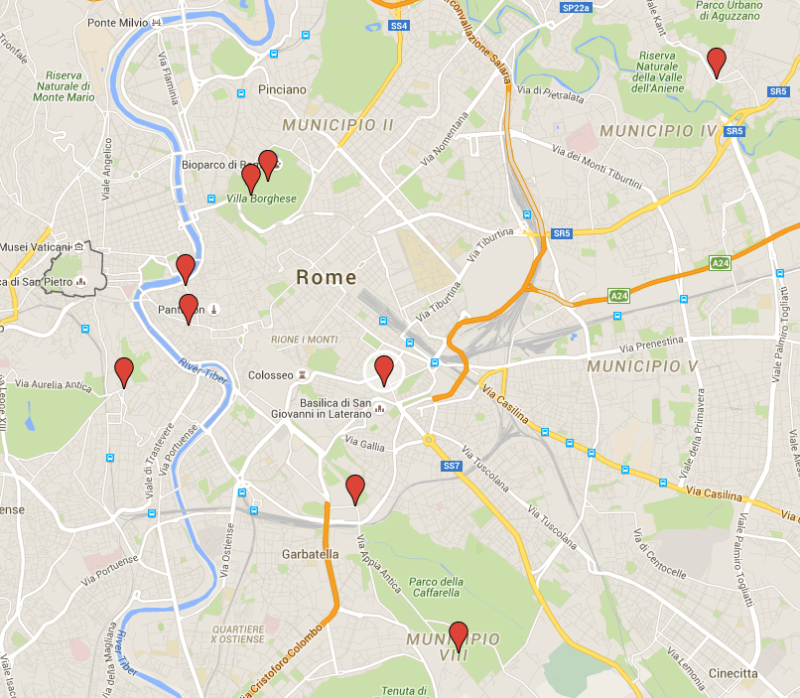Roman nine free museums are the proof of the low-cost side of Rome. Free museums allow budget travelers to visit not only the open-air free spaces, but also real and important museums.
It means that you can visit them and contemplate their beauty at the cost of 0 EUR!
Museo Napoleonico:
this free museum was builted in the house where Giuseppe Primoli (Napoleon’s nephew) used to live, this museum has been made up thanks to the legacy of Giuseppe Primoli himself, who gifted the house and several memorabilia, belonged to Napoleon, to the city of Rome.
It is incredible how this free museum is plenty of interesting things but at the same time is skipped by almost any “conventional” tour guide, which brings the people here (the museum is located in the centre, few steps far from Castel Sant’Angelo and Saint Peter’s) but does not show them his existence.
Unknown, in this case, is not a synonym of unworthy. Conversely, is a must-see for any history passionate and for families.
The strength of this free museum is to show the human side of a big Emperor and his relatives, together with a various amount of clothes, portraits and decorative objects of 19th century.
Where: Piazza Ponte Umberto I, 1
When: Tue-Sun from 10:00 to 18:00
Web: http://www.museonapoleonico.it
Villa di Massenzio:
three buildings are part of this free museum, which is an evocative archaeologic site, another proof of the greatness and magnificence of the ancient Rome.
The Mausoleum of Romolo is the centre of the museum. It is the tomb of Romolo, the son of Massenzio, who builted it as a memory of the whole family.
The Palazzo is one of the typical buildings of the ancient Rome, and the Circus around is a very rare witness of the pageantry of Roman families celebrations.
It does really deserve a visit, and is also not so far from Martini Bed!
Is strongly recommended to visit it when it’s sunny, as it is a open-air space and should be visited during the Old Appian Way Bike Tour.
Where: Via Appia Antica 153
When: Tue-Sun from 10:00 to 16:00
Web: http://www.villadimassenzio.it
Museo della Repubblica Romana e della Memoria Garibaldina:
close to Porta San Pancrazio, the aim of this museum is to collect the memories of the history of Repubblica Romana, a small republic born in 1849 in Italy, after the revolt of Giuseppe Mazzini, Carlo Armellini and Aurelio Saffi.
It had a short life (only 5 months) but it has been a model of society (republic, with freedom of worship, universal suffrage and common-law marriage) which will became real only 100 years later.
Where: Largo di Porta San Pancrazio
When: Tue-Fri from 10:00 to 14:00, Sat-Sun from 10:00 to 18:00
Web: http://www.museodellarepubblicaromana.it
Museo Pietro Canonica:
a rare and unique free museum which offers to the visitors both an exhibition of the sculptures of the artist and a visit to the apartment where he used to live, together with the oils and the memorabilia of the artist himself.
It also collects the studies of the artist and his projects about architecture and sculpture, which make this museum a must-see for anyone who is interested in art studies.
Furthermore, it is located in the big and beautiful “Villa Borghese”. it really deserves a visit.
Where: Viale Pietro Canonica (Piazza di Siena) 2
When: Tue-Sun from 10:00 to 16:00 (October-May), from 13:00 to 19:00 (June-September)
Web: http://www.museocanonica.it
Museo Carlo Bilotti:
another free museum located in Villa Borghese.
It contains the artwork of Giorgio de Chirico, Andy Warhol, Larry Rivers and Giacomo Manzù and several temporary exhibition of various artists.
The museum itself is a sort of monument of contemporary art.
Strongly reccomanded!
Where: Viale Fiorello La Guardia (Villa Borghese)
When: Tue-Fri from 10:00 to 16:00, Sat and Sun from 10:00 to 19:00
Web: http://www.museocarlobilotti.it/
Museo delle Mura:
a free walk inside the Roman wall, surrounding the city.
The museum concerns the history of Roman walls, their evolution throughout the time, and their defensive role.
It deserves a visit during the summer, or within a sunny day.
Where: Via di Porta San Sebastiano, 18
When: Tu-Sun from 9:00 to 14:00
Web: http://www.museodellemuraroma.it/
Museo di Scultura Antica Giovanni Barracco:
Giovanni Barracco was a whealty collector who donated all his collection to Rome after his death.
The free museum is small but contains hundreds of memorabilia of classical and oriental art. The location, between piazza Navona and Campo de’Fiori, makes easy to visit it during a truistic walk in the city centre.
Where: Corso Vittorio Emanuele 166/A
When: Tue-Sun from 10:00 to 16:00 (October to May), from 13:00 to 19:00 (June to September)
Web: http://www.museobarracco.it
Museo di Casal de’ Pazzi:
the free museum has been builded above the findings of a deposit containing thousands of small rests of fossils, dating back to the pleistocene.
It also provide and interactive area for children.
The entrance is allowed only through reservation (call the number 060608), and is not possible to get in after the exhibition starts.
Where: Via Ciliciano (cross with Via E. Galbani – Rebibbia metro stop)
When: Tue-Sun, entrance allowed at 10:00, 11:00, 12:00 and 13:00
Web: http://www.museiincomuneroma.it/
Museo della Liberazione:
the free museum is a collection of documents (texts, photos and videos) about the “resistance” of Italian people against the occupation of nazist during the Second World War and about deportations, imprisonment and massacres of civilians.
Is a monument of the bond between past and present, and the aim is to show the past for learning from it, celebrating freedom and equality.
The free museum is supported by a steering committee consisting of representatives from ministries and cultural associations. It is a real tour of one of the most symbolic place of resistance.
It really deserves a visit.
Where: Via Tasso (Metro A line, Manzoni stop)
When: Tuesday, Thursday and Friday from 15:30 to 19:30, Wednesday, Saturday and Sunday from 9:30 to 12:30
